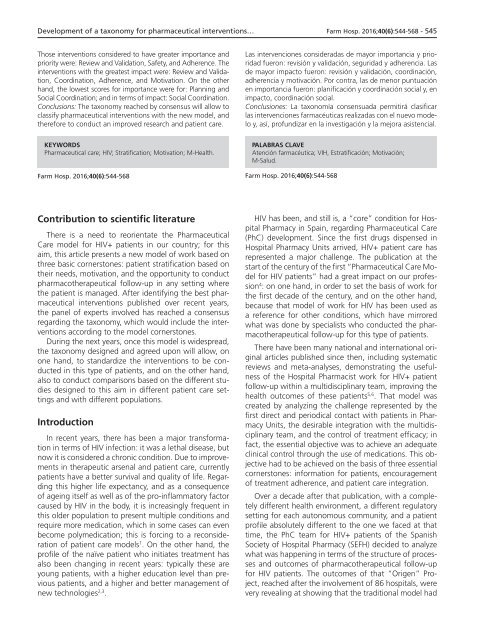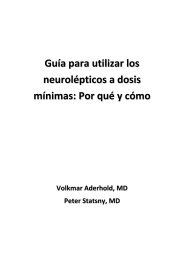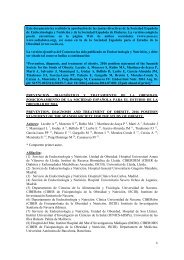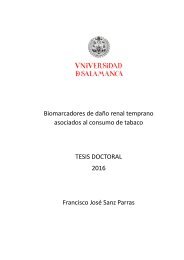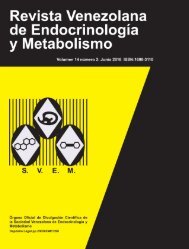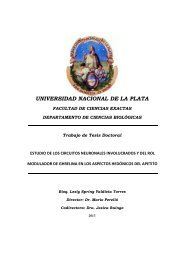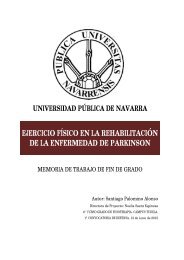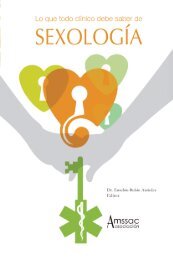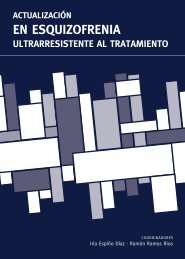Noviembre-Diciembre
156_v40n6(1)
156_v40n6(1)
You also want an ePaper? Increase the reach of your titles
YUMPU automatically turns print PDFs into web optimized ePapers that Google loves.
Development of a taxonomy for pharmaceutical interventions… Farm Hosp. 2016;40(6):544-568 - 545<br />
Those interventions considered to have greater importance and<br />
priority were: Review and Validation, Safety, and Adherence. The<br />
interventions with the greatest impact were: Review and Validation,<br />
Coordination, Adherence, and Motivation. On the other<br />
hand, the lowest scores for importance were for: Planning and<br />
Social Coordination; and in terms of impact: Social Coordination.<br />
Conclusions: The taxonomy reached by consensus will allow to<br />
classify pharmaceutical interventions with the new model, and<br />
therefore to conduct an improved research and patient care.<br />
Las intervenciones consideradas de mayor importancia y prioridad<br />
fueron: revisión y validación, seguridad y adherencia. Las<br />
de mayor impacto fueron: revisión y validación, coordinación,<br />
adherencia y motivación. Por contra, las de menor puntuación<br />
en importancia fueron: planificación y coordinación social y, en<br />
impacto, coordinación social.<br />
Conclusiones: La taxonomía consensuada permitirá clasificar<br />
las intervenciones farmacéuticas realizadas con el nuevo modelo<br />
y, así, profundizar en la investigación y la mejora asistencial.<br />
KEYWORDS<br />
Pharmaceutical care; HIV; Stratification; Motivation; M-Health.<br />
Farm Hosp. 2016;40(6):544-568<br />
PALABRAS CLAVE<br />
Atención farmacéutica; VIH, Estratificación; Motivación;<br />
M-Salud.<br />
Farm Hosp. 2016;40(6):544-568<br />
Contribution to scientific literature<br />
There is a need to reorientate the Pharmaceutical<br />
Care model for HIV+ patients in our country; for this<br />
aim, this article presents a new model of work based on<br />
three basic cornerstones: patient stratification based on<br />
their needs, motivation, and the opportunity to conduct<br />
pharmacotherapeutical follow-up in any setting where<br />
the patient is managed. After identifying the best pharmaceutical<br />
interventions published over recent years,<br />
the panel of experts involved has reached a consensus<br />
regarding the taxonomy, which would include the interventions<br />
according to the model cornerstones.<br />
During the next years, once this model is widespread,<br />
the taxonomy designed and agreed upon will allow, on<br />
one hand, to standardize the interventions to be conducted<br />
in this type of patients, and on the other hand,<br />
also to conduct comparisons based on the different studies<br />
designed to this aim in different patient care settings<br />
and with different populations.<br />
Introduction<br />
In recent years, there has been a major transformation<br />
in terms of HIV infection: it was a lethal disease, but<br />
now it is considered a chronic condition. Due to improvements<br />
in therapeutic arsenal and patient care, currently<br />
patients have a better survival and quality of life. Regarding<br />
this higher life expectancy, and as a consequence<br />
of ageing itself as well as of the pro-inflammatory factor<br />
caused by HIV in the body, it is increasingly frequent in<br />
this older population to present multiple conditions and<br />
require more medication, which in some cases can even<br />
become polymedication; this is forcing to a reconsideration<br />
of patient care models 1 . On the other hand, the<br />
profile of the naïve patient who initiates treatment has<br />
also been changing in recent years: typically these are<br />
young patients, with a higher education level than previous<br />
patients, and a higher and better management of<br />
new technologies 2,3 .<br />
HIV has been, and still is, a “core” condition for Hospital<br />
Pharmacy in Spain, regarding Pharmaceutical Care<br />
(PhC) development. Since the first drugs dispensed in<br />
Hospital Pharmacy Units arrived, HIV+ patient care has<br />
represented a major challenge. The publication at the<br />
start of the century of the first “Pharmaceutical Care Model<br />
for HIV patients” had a great impact on our profession<br />
4 : on one hand, in order to set the basis of work for<br />
the first decade of the century, and on the other hand,<br />
because that model of work for HIV has been used as<br />
a reference for other conditions, which have mirrored<br />
what was done by specialists who conducted the pharmacotherapeutical<br />
follow-up for this type of patients.<br />
There have been many national and international original<br />
articles published since then, including systematic<br />
reviews and meta-analyses, demonstrating the usefulness<br />
of the Hospital Pharmacist work for HIV+ patient<br />
follow-up within a multidisciplinary team, improving the<br />
health outcomes of these patients 5,6 . That model was<br />
created by analyzing the challenge represented by the<br />
first direct and periodical contact with patients in Pharmacy<br />
Units, the desirable integration with the multidisciplinary<br />
team, and the control of treatment efficacy; in<br />
fact, the essential objective was to achieve an adequate<br />
clinical control through the use of medications. This objective<br />
had to be achieved on the basis of three essential<br />
cornerstones: information for patients, encouragement<br />
of treatment adherence, and patient care integration.<br />
Over a decade after that publication, with a completely<br />
different health environment, a different regulatory<br />
setting for each autonomous community, and a patient<br />
profile absolutely different to the one we faced at that<br />
time, the PhC team for HIV+ patients of the Spanish<br />
Society of Hospital Pharmacy (SEFH) decided to analyze<br />
what was happening in terms of the structure of processes<br />
and outcomes of pharmacotherapeutical follow-up<br />
for HIV patients. The outcomes of that “Origen” Project,<br />
reached after the involvement of 86 hospitals, were<br />
very revealing at showing that the traditional model had


